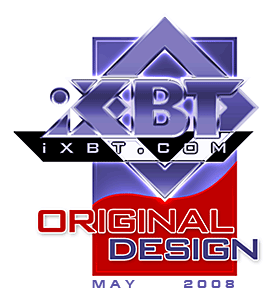Gigabyte MA78GM-S2H Motherboard
|
Performance
Testbed configuration:
- Processors: AMD Athlon 64 X2 4000+
- Memory: 2 x 1 GB Kingston KHX7200D2K2/1G (DDR2-800, 5-5-5-15)
- Graphics card: ATI Radeon X1900 XTX, 512 MB GDDR3
- HDD: Seagate Barracuda 7200.10 (SATA, 7200 rpm)
- PSU: Chieftec CFT-560-A12C
- OS: Windows XP SP2
First of all, we compared this motherboard with the only product on this chipset we previously tested. Besides, we found out how performance changed due to the upgrade from Catalyst 8.1 to 8.3.
| Test |
integrated graphics |
discrete graphics |
| ECS A780GM-A |
Gigabyte MA78GM-S2H
(Catalyst 8.1) |
Gigabyte MA78GM-S2H
(Catalyst 8.3) |
ECS A780GM-A |
Gigabyte MA78GM-S2H |
| Archiving with 7-Zip, min:sec |
6:55 |
6:47 |
6:42 |
6:43 |
6:40 |
| MPEG4 (XviD) encoding, min:sec |
6:11 |
6:06 |
6:04 |
6:06 |
6:04 |
| Unreal Tournament 2004 (Medium@800x600),
fps |
46.5 |
46.3 |
46.9 |
56.2 |
56.9 |
| Unreal Tournament 2004 (High@1024x768),
fps |
37.5 |
37.5 |
38.0 |
56.4 |
57.0 |
| Unreal Tournament 2004 (Highest@1600x1200),
fps |
17.7 |
17.7 |
17.7 |
55.8 |
56.0 |
| FarCry (Medium@800x600), fps |
69.1 |
69.1 |
70.0 |
125.0 |
121.7 |
| FarCry (High@1024x768), fps |
47.4 |
47.3 |
48.1 |
127.1 |
121.6 |
| FarCry (Highest@1600x1200), fps |
21.2 |
21.2 |
21.1 |
125.3 |
121.0 |
| DOOM III (Medium@800x600), fps |
42.1 |
42.3 |
43.1 |
133.6 |
132.7 |
| DOOM III (High@1024x768), fps |
29.2 |
29.2 |
29.8 |
133.1 |
132.0 |
| DOOM III (Highest@1600x1200), fps |
13.7 |
13.7 |
13.8 |
107.7 |
108.7 |
Performance differences are minimal. Only in arithmetic tests with the integrated graphics core the motherboard from Gigabyte sets minor timings in a more rational way than the ECS product. Catalyst 8.3 slightly improves interaction between a GPU and memory, no other visible differences.
But let's see how the GPU performs in overclocked mode, and evaluate performance in modern games. We've chosen Company of Heroes and S.T.A.L.K.E.R., but we didn't lower or raise graphics quality settings, as in our tests of graphics cards. We selected average image quality in Company of Heroes. In S.T.A.L.K.E.R. we allowed the game to evaluate PC performance and choose settings automatically. Perhaps a user can raise image quality a little without decreasing performance after some experimenting (by lowering some subjectively less important settings and raising the others). You can see the image quality during our tests on the following screenshots. Click on the thumbnails to see the full-sized picture.
Company of Heroes
S.T.A.L.K.E.R.
We've got the following performance results:
| Test |
Nominal clock
(500 MHz) |
Overclocked
(680 MHz) |
| average fps |
min fps |
average fps |
min fps |
| Company of Heroes (800x600), fps |
37.9 |
23.6 |
45.5 |
28.5 |
| Company of Heroes (1024x768), fps |
24.4 |
13.7 |
29.1 |
19.1 |
| S.T.A.L.K.E.R. (800x600), fps |
62.1 |
19.6 |
70.7 |
20.7 |
| S.T.A.L.K.E.R. (1024x768), fps |
41.7 |
12.6 |
47.5 |
14.7 |
Our sample allowed to boot up Windows even with the GPU overclocked to 800 MHz. But the maximum stable clock rate in games was 720 MHz with the Northbridge voltage raised by 0.2 V. 680 MHz was absolutely stable at the standard voltage and without additional cooling, so we ran our tests at this very frequency. Judging by reports of our colleagues, this is not the maximum frequency for motherboards on this chipset. We've heard of stable overclocking to 800 MHz and higher. Any overclocking attempt is a lottery.
However, even our result allows to raise the average frame rate by 12-20%. What concerns our general impressions from our tests, they are unusual. We just didn't expect such results in executing shaders from this graphics core integrated into the motherboard and covered with such a small heat sink.
Conclusions
To all appearances, Gigabyte managed to cram maximum functionality into this microATX board. It can be recommended for a media center or inexpensive home PC, to which you can add a graphics card (if you want to play games, for example). The chipset contributed much to our positive impressions of the motherboard, of course. But we decided that it still deserves our Original Design award. Originality of motherboards does not always show in special curves of heat pipes on expensive chipsets. We should also encourage rational solutions.
Meanwhile, we carry on examining new integrated chipsets. We are going to test Hybrid CrossFire in the next motherboard to be reviewed.
Motherboard provided by the manufacturer
Write a comment below. No registration needed!
|
|
 |
|
|
|

